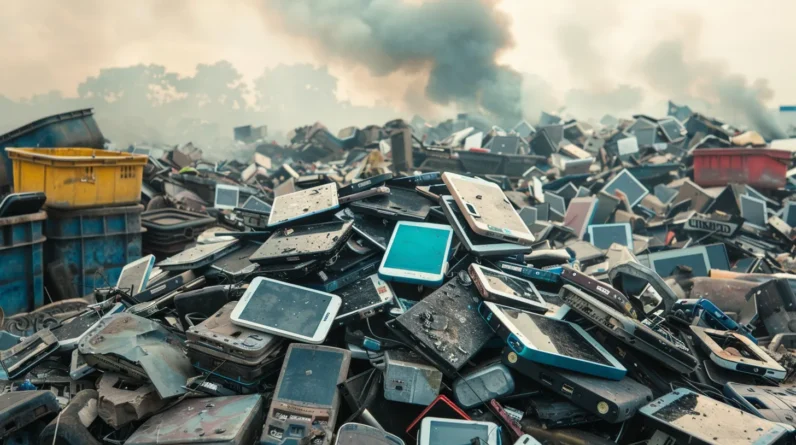
In our modern world, smart devices have become emblematic of progress and connectivity. However, behind the sleek screens and cutting-edge technology lies a growing concern that demands our attention.
The disposal of these devices, often termed as e-waste, raises significant environmental and health issues. From toxic chemicals to the sheer volume of discarded gadgets, the repercussions are vast.
Understanding how to responsibly manage e-waste is not just a choice but a pressing necessity for safeguarding our planet’s future. Let’s explore the imperative need for proper disposal methods to mitigate the adverse effects on our environment.
Environmental Impact of E-Waste
When we discard smart devices, the environmental impact of e-waste becomes a pressing concern that demands our attention. The improper disposal of electronic devices contributes significantly to pollution and resource depletion.
In 2019 alone, approximately 53.6 million metric tons of e-waste was generated globally, with only 17.4% being recycled. This highlights a critical issue in our current waste management practices. To address this challenge, we must prioritize responsible recycling methods and promote circular economies that encourage the reuse and recycling of electronic components.
Implementing extended producer responsibility programs, where manufacturers take back old devices for proper disposal or refurbishment, can significantly reduce the environmental footprint of e-waste. By adopting sustainable practices and raising awareness, we can mitigate the adverse effects of e-waste on our planet.
Toxic Components in Smart Devices
Examining the presence of toxic components in smart devices reveals the potential risks they pose to both environmental and human health. Smart devices contain hazardous materials like lead, mercury, cadmium, arsenic, and flame retardants.
When improperly disposed of, these toxins can leach into the soil and water, contaminating ecosystems and posing serious health risks to living organisms. For instance, lead exposure can lead to neurological disorders, while cadmium is a known carcinogen.
To mitigate these risks, it’s essential to promote responsible e-waste recycling practices. By implementing proper recycling methods, such as extracting and safely disposing of toxic components, we can minimize the environmental and health impacts associated with smart device disposal.
Volume of Discarded Smart Gadgets
The prevalence of toxic components in smart devices underscores the pressing issue of the volume of discarded smart gadgets and its impact on the environment and public health. As we delve into the data surrounding this topic, it becomes evident that:
– Each year, millions of smartphones, tablets, and laptops are disposed of improperly.
– Electronic waste, including smart gadgets, contains hazardous substances like lead and mercury.
– Improper disposal leads to these toxic components leaching into soil and water sources.
– The increasing volume of discarded smart devices necessitates sustainable recycling solutions to mitigate environmental and health risks.
Importance of Responsible Disposal
With the escalating global consumption of smart devices, the responsible disposal of these gadgets has become a critical imperative to safeguard the environment and public health. Improper disposal of electronic waste can lead to toxic substances leaching into soil and water sources, posing serious health risks.
According to the Global E-waste Monitor 2020, a staggering 53.6 million metric tons of electronic waste was generated worldwide, highlighting the pressing need for responsible disposal practices. Recycling smart devices not only conserves valuable resources but also reduces the energy required for manufacturing new products.
Minimizing Negative Environmental Impact
To minimize the negative environmental impact of smart device disposal, implementing stringent recycling regulations is essential. By ensuring that e-waste is managed responsibly, we can significantly reduce the harmful effects on our planet.
To achieve this, consider the following actions:
– Promote Extended Producer Responsibility (EPR) programs: Holding manufacturers accountable for the entire lifecycle of their products encourages sustainable design and recycling practices.
– Facilitate convenient e-waste collection points: Making it easy for consumers to recycle their old devices increases the likelihood of proper disposal.
– Encourage eco-friendly disposal methods: Supporting the refurbishment and resale of used devices reduces the need for raw materials and minimizes waste.
– Educate the public on e-waste impact: Raising awareness about the environmental consequences of improper disposal fosters a culture of responsible e-waste management.
Conclusion
The alarming environmental impact of e-waste can’t be ignored. With toxic components in smart devices and a growing volume of discarded gadgets, responsible disposal is crucial.
By minimizing negative environmental impact through proper recycling and disposal methods, we can make a significant difference. Remember, when it comes to e-waste, it’s time to ‘put our money where our mouth is’ and take action to protect our planet.







